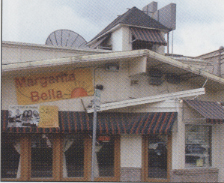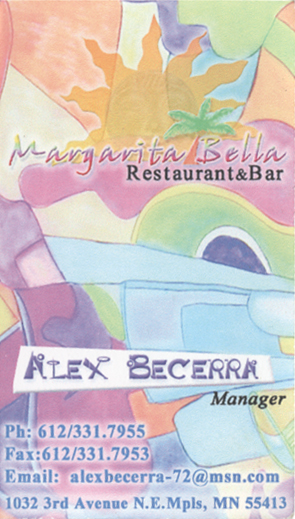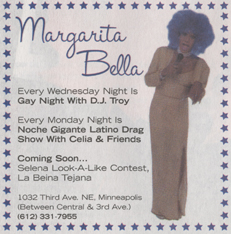Difference between revisions of "Margarita Bella"
(New page: Image:Svc_mgtabella.jpg Margarita Bella business card. Courtesy of the Jean-Nickolaus Tretter Collection. ---- This page is still under construction. -SVC Part of [[Minneapo...) |
|||
| (10 intermediate revisions by 3 users not shown) | |||
| Line 1: | Line 1: | ||
| − | [[Image:Svc_mgtabella.jpg ]] | + | <div style="text-align: center;"> |
| − | Margarita Bella | + | '''1032 3rd Ave NE, Minneapolis, MN''' |
| + | </div> | ||
| + | |||
| + | |||
| + | {{unrotected}} | ||
| + | {| {{prettytable}} | ||
| + | ! | ||
| + | ! | ||
| + | |- | ||
| + | | <div style="text-align: center;"> | ||
| + | [[Image:Svc_mgtabella.jpg]] | ||
| + | </div> <div style="text-align: center;"> | ||
| + | <small>'''Business card of a Margarita Bella employee, who is also an artist. Courtesy of the [[Jean-Nickolaus Tretter Collection]].'''</small> | ||
| + | </div> | ||
| + | | The Twin Cities have been home to an active Hispanic population for most of the 20th century. Initially, immigrants from Mexico settled on the [[West Side Flats]] in St. Paul, but as time progressed,<small>(1)</small> Chicano and Latino people migrated to most of St. Paul’s West Side and to South Central Minneapolis. Imbued with a spirit of entrepreneurialism, the communities revitalized declining commercial corridors and re-established a sense of place to depressed areas.<small>(2)</small> | ||
| + | |||
| + | |||
| + | The populations also added a much-needed vibrancy and diversity to the prevailing culture of Minnesota, which was once dictated by German, Irish, and Scandinavian immigrants.<small>(3)</small> The influence of Hispanic culture is even evident in neighborhoods outside of Chicano/Latino neighborhoods—this is the case with Margartia Bella. | ||
| + | |||
| + | |||
| + | Raul Sacta—an Ecuadorian immigrant—opened Margarita Bella in Northeast Minneapolis after a strenuous license contest with the city of Minneapolis.<small>(4)</small> He did not open the bar purely for LGBT Latinos; instead, the businessman opened his doors to everyone. The establishment’s popularity with the whole Hispanic community inspired a similar popularity among queer people. In many respects, Margarita Bella became the first queer Hispanic bar in the Twin Cities. | ||
| + | |} | ||
| + | |||
| + | |||
| + | The establishment’s opening had perfect timing. Immigrants from Latin America carry the stigmas of their home countries with them, and HIV/AIDS is a subject that is surrounded with misinformation all over the world. Locally, these myths ranged from assumptions of homosexuality to the belief that one could be arrested for carrying the virus.<small>(5)</small> | ||
| + | {| {{prettytable}} | ||
| + | ! | ||
| + | ! | ||
| + | ! | ||
| + | |- | ||
| + | | [[Image:Svc_mbella.jpg]] '''<small>'''The Exterior of Margartia Bella in the 2000s.'''</small>''' | ||
| + | | In addition to weekly “Gay Nights” and drag shows, Margarita Bella hosted evenings with “La Coco,” a drag queen who instructed patrons about safe sex and other forms of HIV/AIDS prevention.<small>(6)</small> Sadly, this essential community establishment closed due to financial issues. | ||
| + | | <div style="text-align: center;"> | ||
| + | [[Image:Svc_mbelladrag.jpg]] | ||
| + | </div> <div style="text-align: center;"> | ||
| + | <small>'''Advertisement for Magarita Bella's weekly drag shows. Courtesy of the [[Jean-Nickolaus Tretter Collection]].'''</small> | ||
| + | </div> | ||
| + | |} | ||
| + | Presently, the site is occupied by a gay piano/sports bar named Tickles. | ||
---- | ---- | ||
| − | This | + | ==This entry is part of:== |
| + | == [[Minneapolis/St. Paul, MN: 100 Queer Places in Minnesota History, (1860-2010)]]== | ||
| + | ---- | ||
| + | |||
| + | |||
| + | ---- | ||
| + | |||
| + | |||
| + | <small>(1)</small> Millet, Larry. AIA guide to the Twin Cities. St. Paul: Minnesota Historical Society Press, 2007. Page 401. | ||
| + | |||
| + | <small>(2)</small> Nelson, Paul; Lyons, Lisa; and Peterson, Cassie. Tour St. Paul: West Side. St. Paul: Tour St. Paul, N.D. | ||
| + | |||
| + | <small>(3)</small> Holmquist, June Drenning. They Chose Minnesota:A Survey of the State's Ethnic Groups. St. Paul: Minnesota Historical Society Press, 1981. Pages 111-296. | ||
| + | |||
| + | <small>(4)</small> "Proposed Bar in Cedar-Riverside at Center of Development Brawl" ''The Minneapolis Star-Tribune, '' 3/4/2002 | ||
| + | |||
| + | <small>(5)</small>Vazquez Toness, Bianca. "Latino HIV AIDS Education Takes to the Streets." Minnesota Public Radio, 5/9/2005. | ||
| + | |||
| + | <small>(6)</small> ''Ibid.'' | ||
Part of [[Minneapolis/St. Paul, MN: 100 Queer Places in Minnesota History, (1860-1969), (1969-2010)]] | Part of [[Minneapolis/St. Paul, MN: 100 Queer Places in Minnesota History, (1860-1969), (1969-2010)]] | ||
Latest revision as of 05:26, 2 February 2012
1032 3rd Ave NE, Minneapolis, MN
| Business card of a Margarita Bella employee, who is also an artist. Courtesy of the Jean-Nickolaus Tretter Collection. |
The Twin Cities have been home to an active Hispanic population for most of the 20th century. Initially, immigrants from Mexico settled on the West Side Flats in St. Paul, but as time progressed,(1) Chicano and Latino people migrated to most of St. Paul’s West Side and to South Central Minneapolis. Imbued with a spirit of entrepreneurialism, the communities revitalized declining commercial corridors and re-established a sense of place to depressed areas.(2)
|
The establishment’s opening had perfect timing. Immigrants from Latin America carry the stigmas of their home countries with them, and HIV/AIDS is a subject that is surrounded with misinformation all over the world. Locally, these myths ranged from assumptions of homosexuality to the belief that one could be arrested for carrying the virus.(5)
 The Exterior of Margartia Bella in the 2000s. The Exterior of Margartia Bella in the 2000s.
|
In addition to weekly “Gay Nights” and drag shows, Margarita Bella hosted evenings with “La Coco,” a drag queen who instructed patrons about safe sex and other forms of HIV/AIDS prevention.(6) Sadly, this essential community establishment closed due to financial issues. | Advertisement for Magarita Bella's weekly drag shows. Courtesy of the Jean-Nickolaus Tretter Collection. |
Presently, the site is occupied by a gay piano/sports bar named Tickles.
This entry is part of:
Minneapolis/St. Paul, MN: 100 Queer Places in Minnesota History, (1860-2010)
(1) Millet, Larry. AIA guide to the Twin Cities. St. Paul: Minnesota Historical Society Press, 2007. Page 401.
(2) Nelson, Paul; Lyons, Lisa; and Peterson, Cassie. Tour St. Paul: West Side. St. Paul: Tour St. Paul, N.D.
(3) Holmquist, June Drenning. They Chose Minnesota:A Survey of the State's Ethnic Groups. St. Paul: Minnesota Historical Society Press, 1981. Pages 111-296.
(4) "Proposed Bar in Cedar-Riverside at Center of Development Brawl" The Minneapolis Star-Tribune, 3/4/2002
(5)Vazquez Toness, Bianca. "Latino HIV AIDS Education Takes to the Streets." Minnesota Public Radio, 5/9/2005.
(6) Ibid.
Part of Minneapolis/St. Paul, MN: 100 Queer Places in Minnesota History, (1860-1969), (1969-2010)

